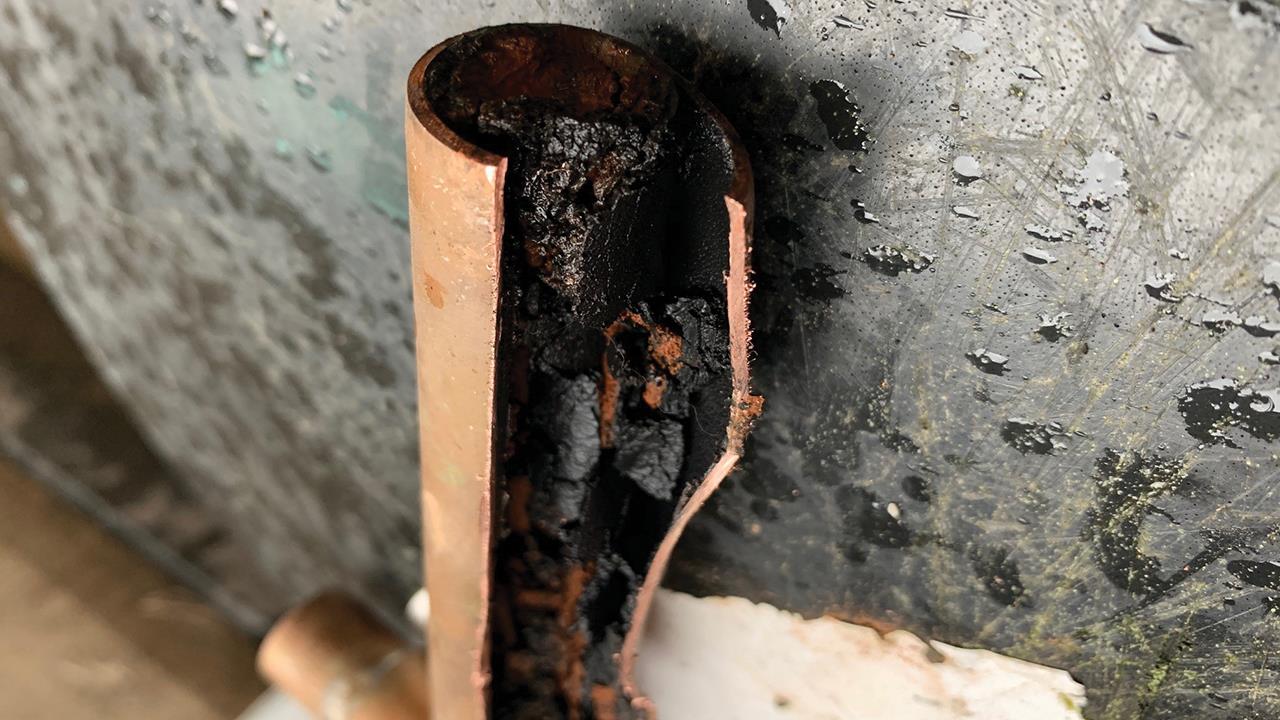

Cold spots on radiators are a familiar issue for heating engineers. They are commonly caused by the radiator pulling air into the system, and are remedied by simply bleeding the radiator. But look more closely and you may find that the oxygen that has been trapped in the system will have helped corrode the metal components, causing a build-up of magnetite particles that have turned into a thick, brown liquid called sludge.
We call this build-up ‘pyramiding’, from the fact that when the water travels up and over it to get around the system, the accumulation of sludge starts to take the shape of a pyramid at the bottom of the radiator. This creates a barrier inside the radiator which prevents heat from coming through properly. As a result, radiators may feel colder at the bottom than the top.
Showing the problem
Magnetite comprises tiny particles floating around in a system. Taking a water sample and simply showing it to the customer may not be effective in fully explaining the extent of the issue. It’s therefore understandable that a customer may be hesitant about going forward with remedial action to improve a system’s water quality, particularly if they are already taking on other maintenance expenses such as repairs or replacements.
By using a water testing solution, such as ADEY ProCheck, you can demonstrate to customers the main causes of poor water quality with instant lab-style results indicating corrosion, inhibitor, and pH levels. This helps the customer to better understand the state of the water inside their heating system – essentially making the invisible sludge problem visible.
Talking through the results can also help open the door to discussing remedial actions, such as system flushing or inhibitor dosing. By showing customers visually what is happening, any further action can be agreed without delay, reducing the need for return visits, and keeping costs down for homeowners.
Solving the problem
Ultimately, the build-up of sludge affects radiator performance, so even though a customer may have turned their heating up to maximum, they may not feel the full benefit.
Treating the sludge inside the system and establishing preventative measures to keep the corrosion at bay allows radiators to produce up to 47% more heat without using more energy because the system will work more efficiently. This has the potential to reduce energy bills, and lower carbon emissions by up to 7%, according to independent research commissioned by ADEY.
If a heating system is heavily sludged up, there could be a great deal of corrosion settled in the radiators and pipework that can’t be removed by filters alone. To shift heavily settled magnetite and rust, a cleaner will need to be added to the system so that it can circulate and lift the sludge.
You may need to use an agitator on the more stubborn magnetite to lift the sludge from the bottom of the radiator and subsequently flush it through.
For example, ADEY’s MagnaCleanse includes the Vibraclean agitator which, when used with a drill on the chisel setting, can help dislodge more deep-seated sludge from the base of the radiators without needing to remove the radiator itself. After the more stubborn sludge has been lifted, a full system flush can be performed to remove virtually all the magnetite.
If you are concerned about the integrity of a system, use a cleaner that incorporates the heat and flow from the boiler. This will deliver a fast and effective, yet gentle, flushing process, making it ideal for all systems, including older ones.
Protecting against further problems
A full system flush will remove virtually all the magnetite in a system, but it won’t keep it at bay. To ensure the system is protected, a filter should be added. A magnetic filter is more effective than a mesh filter as it will capture even the smallest of magnetite particles. It filters out sludge before it goes through the vital parts of the heating system, and helps protect the boiler from breaking down, which means it can run more efficiently.
To prevent magnetite from forming in the future, and to protect the metal components inside radiators, dosing the system with inhibitor is essential. Inhibitor forms a protective layer over metal components, helping to keep corrosion at bay and protecting the central heating system to ensure longevity.
Once you have taken the necessary steps to resolve the customer’s issue with their heating system, you can complete a second water test to show how the techniques you have used have helped improve the water quality. This side-by-side comparison reassures the customer that the system is now running at the highest efficiency, helping you as an installer to build customer trust and retain their business.
If you'd like to keep up-to-date with the latest developments in the heating and plumbing industry, why not subscribe to our weekly newsletters? Just click the button below and you can ensure all the latest industry news and new product information lands in your inbox every week.